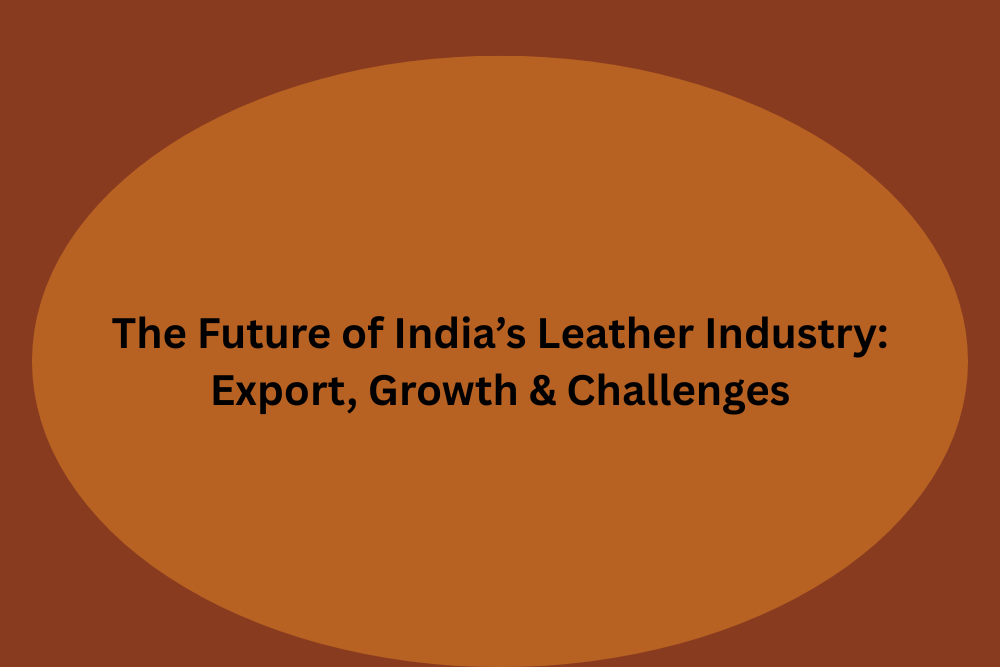India’s leather industry has long been recognized as a pillar of the country’s manufacturing and export economy. From handcrafted footwear to high-quality leather goods, the sector contributes significantly to employment, foreign exchange, and industrial development. However, with changing global trends, evolving environmental regulations, and shifting demand patterns, the industry stands at a critical point. This article explores the future of India’s leather industry, focusing on export potential, growth opportunities, and key challenges.
A Snapshot of India’s Leather Industry Today
India is one of the largest producers of leather and leather products in the world. The country ranks among the top exporters of leather footwear, accessories, and garments. With over 4 million people employed directly or indirectly, the industry supports thousands of small, medium, and large-scale enterprises.
Key leather production clusters are located in Tamil Nadu (Chennai, Vellore), Uttar Pradesh (Kanpur, Agra), West Bengal (Kolkata), Maharashtra (Mumbai), Punjab (Jalandhar), and Haryana (Faridabad).
Major Leather Products Exported:
- Finished leather
- Leather footwear
- Leather goods (bags, belts, wallets)
- Leather garments
- Saddlery and harness items
India’s leather exports reached USD 3.5 billion in recent years, catering mainly to markets like the USA, Germany, the UK, France, and the UAE.
Export Potential: Where the Opportunity Lies
India’s leather industry continues to have a competitive edge in global markets due to its abundant raw material, skilled labor force, and diverse product range. With rising global demand for sustainable and ethically produced goods, India can position itself as a reliable sourcing destination.
Factors Driving Export Growth:
- Diversified product portfolio catering to fashion and utility markets
- Cost-effective production compared to European countries
- Government initiatives under Make in India and the Production Linked Incentive (PLI) Scheme
- Bilateral trade agreements with key markets
In the post-pandemic global economy, buyers are also exploring China+1 sourcing strategies, presenting India with an opportunity to increase its market share. Exporters who maintain high standards in quality, compliance, and sustainability are well-placed to benefit.
Growth Opportunities in Domestic and International Markets
While export remains a primary revenue stream, domestic demand for leather products is also rising due to changing lifestyles, increased urbanization, and a growing middle-class population.
Emerging Growth Trends:
- Footwear retail expansion in urban and tier-2 cities
- Fashion accessories demand from Indian youth and working professionals
- E-commerce boom, which has increased visibility and sales for small leather brands
- Skill development initiatives to upgrade the workforce and meet global standards
- Rise in contract manufacturing for international luxury brands
Furthermore, technology adoption in design, manufacturing, and inventory management is helping Indian leather companies improve productivity and meet international buyer expectations.
Environmental & Ethical Challenges
Despite its potential, India’s leather sector faces significant challenges, particularly in the areas of environmental sustainability, compliance, and global perception.
1. Pollution Control and Environmental Compliance
Tanning and dyeing processes are resource-intensive and can cause serious environmental harm if not managed properly. While many tanneries have adopted cleaner technologies, others continue to face scrutiny for not meeting pollution control norms. Central Effluent Treatment Plants (CETPs) in leather hubs like Kanpur and Tamil Nadu are under pressure to meet stricter discharge standards.
2. Global Regulations and Certifications
International buyers increasingly require compliance with environmental, labor, and ethical standards such as:
- Leather Working Group (LWG) certification
- REACH (Registration, Evaluation, Authorisation, and Restriction of Chemicals)
- ISO 14001 for environmental management
Non-compliance with these standards can lead to loss of export orders and buyer trust.
3. Raw Material Shortage and Import Dependence
India imports certain types of hides and chemicals for processing, making the industry vulnerable to price fluctuations and trade restrictions.
Social Responsibility and Labor Welfare
The leather industry, particularly in the unorganized sector, is often criticized for inadequate working conditions, low wages, and lack of social security. This not only affects worker well-being but also tarnishes the industry’s image in global markets.
The way forward lies in:
- Formalizing employment structures
- Investing in worker safety and training
- Implementing fair wage practices
- Promoting gender inclusivity in leather jobs
Government support and private sector partnerships can ensure sustainable labor practices across the value chain.
Government Support and Industry Reform
The Indian government has launched several schemes to revive and modernize the leather sector:
Key Initiatives:
- Indian Footwear and Leather Development Programme (IFLDP) offering financial support for infrastructure, technology upgrade, and workforce training
- Mega Leather Clusters to support common facilities and economies of scale
- Skill India Mission to provide training to youth and improve employability
- Export promotion councils like CLE (Council for Leather Exports) providing market access and trade facilitation
Timely implementation of these schemes, along with ease-of-doing-business reforms, will play a vital role in boosting the sector’s competitiveness.
The Road Ahead: Strategies for a Sustainable Future
To ensure long-term growth and profitability, India’s leather industry must embrace a multi-pronged strategy that includes:
- Modernization of manufacturing facilities
- Adoption of sustainable and eco-friendly tanning methods
- Investment in research and innovation
- Brand building to shift from low-margin manufacturing to value-added products
- Strengthening domestic supply chains to reduce import dependency
At the same time, collaboration between industry stakeholders, academic institutions, and policymakers will be crucial to aligning the sector with global expectations.
Conclusion
India’s leather industry holds immense potential for growth, job creation, and export expansion. However, to unlock this potential, the sector must address environmental, ethical, and operational challenges through innovation, compliance, and strategic reform.
By upgrading its manufacturing ecosystem, investing in sustainable practices, and building a skilled workforce, India can position itself as a global leader in leather production and exports. The future is promising but it depends on proactive steps taken today.

Leave a Reply